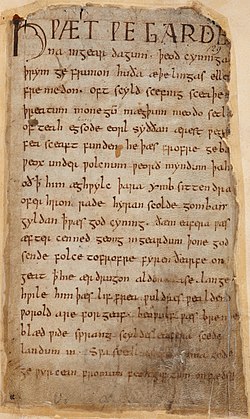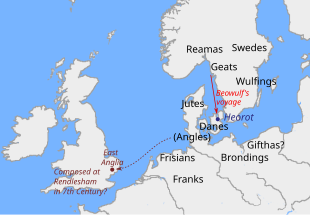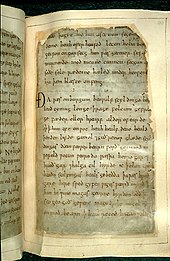Beowulf theme by GunsOfLiberty
Download: Beowulf.p3t

(4 backgrounds)
| Beowulf | |
|---|---|
| Bēowulf | |
 First page of Beowulf in Cotton Vitellius A. xv. Beginning: HWÆT. WE GARDE / na in geardagum, þeodcyninga / þrym gefrunon... (Translation: How much we of Spear-Da/nes, in days gone by, of kings / the glory have heard...) | |
| Author(s) | Unknown |
| Language | West Saxon dialect of Old English |
| Date | Disputed (c. 700–1000 AD) |
| State of existence | Manuscript suffered damage from fire in 1731 |
| Manuscript(s) | Cotton Vitellius A. xv (c. 975–1025 AD) |
| First printed edition | Thorkelin (1815) |
| Genre | Epic heroic writing |
| Verse form | Alliterative verse |
| Length | c. 3182 lines |
| Subject | The battles of Beowulf, the Geatish hero, in youth and old age |
| Personages | Beowulf, Hygelac, Hrothgar, Wealhtheow, Hrothulf, Æschere, Unferth, Grendel, Grendel's mother, Wiglaf, Hildeburh. Full list of characters. |
| Text | Beowulf at Wikisource |
Beowulf (/ˈbeɪəwʊlf/;[1] Old English: Bēowulf [ˈbeːowuɫf]) is an Old English epic poem in the tradition of Germanic heroic legend consisting of 3,182 alliterative lines. It is one of the most important and most often translated works of Old English literature. The date of composition is a matter of contention among scholars; the only certain dating is for the manuscript, which was produced between 975 and 1025 AD.[2] Scholars call the anonymous author the "Beowulf poet".[3] The story is set in pagan Scandinavia in the 5th and 6th centuries. Beowulf, a hero of the Geats, comes to the aid of Hrothgar, the king of the Danes, whose mead hall Heorot has been under attack by the monster Grendel for twelve years. After Beowulf slays him, Grendel's mother takes revenge and is in turn defeated. Victorious, Beowulf goes home to Geatland and becomes king of the Geats. Fifty years later, Beowulf defeats a dragon, but is mortally wounded in the battle. After his death, his attendants cremate his body and erect a barrow on a headland in his memory.
Scholars have debated whether Beowulf was transmitted orally, affecting its interpretation: if it was composed early, in pagan times, then the paganism is central and the Christian elements were added later, whereas if it was composed later, in writing, by a Christian, then the pagan elements could be decorative archaising; some scholars also hold an intermediate position. Beowulf is written mostly in the Late West Saxon dialect of Old English, but many other dialectal forms are present, suggesting that the poem may have had a long and complex transmission throughout the dialect areas of England.
There has long been research into similarities with other traditions and accounts, including the Icelandic Grettis saga, the Norse story of Hrolf Kraki and his bear-shapeshifting servant Bodvar Bjarki, the international folktale the Bear's Son Tale, and the Irish folktale of the Hand and the Child. Persistent attempts have been made to link Beowulf to tales from Homer's Odyssey or Virgil's Aeneid. More definite are biblical parallels, with clear allusions to the books of Genesis, Exodus, and Daniel.
The poem survives in a single copy in the manuscript known as the Nowell Codex. It has no title in the original manuscript, but has become known by the name of the story's protagonist.[3] In 1731, the manuscript was damaged by a fire that swept through Ashburnham House in London, which was housing Sir Robert Cotton's collection of medieval manuscripts. It survived, but the margins were charred, and some readings were lost.[4] The Nowell Codex is housed in the British Library. The poem was first transcribed in 1786; some verses were first translated into modern English in 1805, and nine complete translations were made in the 19th century, including those by John Mitchell Kemble and William Morris. After 1900, hundreds of translations, whether into prose, rhyming verse, or alliterative verse were made, some relatively faithful, some archaising, some attempting to domesticate the work. Among the best-known modern translations are those of Edwin Morgan, Burton Raffel, Michael J. Alexander, Roy Liuzza, and Seamus Heaney. The difficulty of translating Beowulf has been explored by scholars including J. R. R. Tolkien (in his essay "On Translating Beowulf"), who worked on a verse and a prose translation of his own.
Historical background[edit]

The events in the poem take place over the 5th and 6th centuries, and feature predominantly non-English characters. Some suggest that Beowulf was first composed in the 7th century at Rendlesham in East Anglia, as the Sutton Hoo ship-burial shows close connections with Scandinavia, and the East Anglian royal dynasty, the Wuffingas, may have been descendants of the Geatish Wulfings.[6][5] Others have associated this poem with the court of King Alfred the Great or with the court of King Cnut the Great.[7]
The poem blends fictional, legendary, mythic and historical elements. Although Beowulf himself is not mentioned in any other Old English manuscript,[8] many of the other figures named in Beowulf appear in Scandinavian sources.[9] This concerns not only individuals (e.g., Healfdene, Hroðgar, Halga, Hroðulf, Eadgils and Ohthere), but also clans (e.g., Scyldings, Scylfings and Wulfings) and certain events (e.g., the battle between Eadgils and Onela). The raid by King Hygelac into Frisia is mentioned by Gregory of Tours in his History of the Franks and can be dated to around 521.[10]
The majority view appears to be that figures such as King Hrothgar and the Scyldings in Beowulf are based on historical people from 6th-century Scandinavia. Like the Finnesburg Fragment and several shorter surviving poems, Beowulf has consequently been used as a source of information about Scandinavian figures such as Eadgils and Hygelac, and about continental Germanic figures such as Offa, king of the continental Angles.[11] However, the scholar Roy Liuzza argues that the poem is "frustratingly ambivalent", neither myth nor folktale, but is set "against a complex background of legendary history ... on a roughly recognizable map of Scandinavia", and comments that the Geats of the poem may correspond with the Gautar (of modern Götaland); or perhaps the legendary Getae.[12]

19th-century archaeological evidence may confirm elements of the Beowulf story. Eadgils was buried at Uppsala (Gamla Uppsala, Sweden) according to Snorri Sturluson. When the western mound (to the left in the photo) was excavated in 1874, the finds showed that a powerful man was buried in a large barrow, c. 575, on a bear skin with two dogs and rich grave offerings. The eastern mound was excavated in 1854, and contained the remains of a woman, or a woman and a young man. The middle barrow has not been excavated.[14][13]
In Denmark, recent (1986-88, 2004-05)[15] archaeological excavations at Lejre, where Scandinavian tradition located the seat of the Scyldings, Heorot, have revealed that a hall was built in the mid-6th century, matching the period described in Beowulf, some centuries before the poem was composed.[16] Three halls, each about 50 metres (160 ft) long, were found during the excavation.[16]
Summary[edit]

Key: (a) sections 1–2 (b) 3–7 (c) 8–12 (d) 13–18 (e) 19–23 (f) 24–26 (g) 27–31 (h) 32–33 (i) 34–38 (j) 39–43
The protagonist Beowulf, a hero of the Geats, comes to the aid of Hrothgar, king of the Danes, whose great hall, Heorot, is plagued by the monster Grendel. Beowulf kills Grendel with his bare hands, then kills Grendel's mother with a giant's sword that he found in her lair.
Later in his life, Beowulf becomes king of the Geats, and finds his realm terrorised by a dragon, some of whose treasure had been stolen from his hoard in a burial mound. He attacks the dragon with the help of his thegns or servants, but they do not succeed. Beowulf decides to follow the dragon to its lair at Earnanæs, but only his young Swedish relative Wiglaf, whose name means "remnant of valour",[a] dares to join him. Beowulf finally slays the dragon, but is mortally wounded in the struggle. He is cremated and a burial mound by the sea is erected in his honour.
Beowulf is considered an epic poem in that the main character is a hero who travels great distances to prove his strength at impossible odds against supernatural demons and beasts. The poem begins in medias res or simply, "in the middle of things", a characteristic of the epics of antiquity. Although the poem begins with Beowulf's arrival, Grendel's attacks have been ongoing. An elaborate history of characters and their lineages is spoken of, as well as their interactions with each other, debts owed and repaid, and deeds of valour. The warriors form a brotherhood linked by loyalty to their lord. The poem begins and ends with funerals: at the beginning of the poem for Scyld Scefing[20] and at the end for Beowulf.[21]
The poem is tightly structured. E. Carrigan shows the symmetry of its design in a model of its major components, with for instance the account of the killing of Grendel matching that of the killing of the dragon, the glory of the Danes matching the accounts of the Danish and Geatish courts.[17] Other analyses are possible as well; Gale Owen-Crocker, for instance, sees the poem as structured by the four funerals it describes.[22] For J. R. R. Tolkien, the primary division in the poem was between young and old Beowulf.[23]
First battle: Grendel[edit]
Beowulf begins with the story of Hrothgar, who constructed the great hall, Heorot, for himself and his warriors. In it, he, his wife Wealhtheow, and his warriors spend their time singing and celebrating. Grendel, a troll-like monster said to be descended from the biblical Cain, is pained by the sounds of joy.[24] Grendel attacks the hall and kills and devours many of Hrothgar's warriors while they sleep. Hrothgar and his people, helpless against Grendel, abandon Heorot.
Beowulf, a young warrior from Geatland, hears of Hrothgar's troubles and with his king's permission leaves his homeland to assist Hrothgar.[25]
Beowulf and his men spend the night in Heorot. Beowulf refuses to use any weapon because he holds himself to be Grendel's equal.[26] When Grendel enters the hall, Beowulf, who has been feigning sleep, leaps up to clench Grendel's hand.[27] Grendel and Beowulf battle each other violently.[28] Beowulf's retainers draw their swords and rush to his aid, but their blades cannot pierce Grendel's skin.[29] Finally, Beowulf tears Grendel's arm from his body at the shoulder and Grendel runs to his home in the marshes where he dies.[30] Beowulf displays "the whole of Grendel's shoulder and arm, his awesome grasp" for all to see at Heorot. This display would fuel Grendel's mother's anger in revenge.[31]
Second battle: Grendel's mother[edit]
The next night, after celebrating Grendel's defeat, Hrothgar and his men sleep in Heorot. Grendel's mother, angry that her son has been killed, sets out to get revenge. "Beowulf was elsewhere. Earlier, after the award of treasure, The Geat had been given another lodging"; his assistance would be absent in this battle.[32] Grendel's mother violently kills Æschere, who is Hrothgar's most loyal fighter, and escapes.
Hrothgar, Beowulf, and their men track Grendel's mother to her lair under a lake. Unferð, a warrior who had earlier challenged him, presents Beowulf with his sword Hrunting. After stipulating a number of conditions to Hrothgar in case of his death (including the taking in of his kinsmen and the inheritance by Unferth of Beowulf's estate), Beowulf jumps into the lake and, while harassed by water monsters, gets to the bottom, where he finds a cavern. Grendel's mother pulls him in, and she and Beowulf engage in fierce combat.
At first, Grendel's mother prevails, and Hrunting proves incapable of hurting her; she throws Beowulf to the ground and, sitting astride him, tries to kill him with a short sword, but Beowulf is saved by his armour. Beowulf spots another sword, hanging on the wall and apparently made for giants, and cuts her head off with it. Travelling further into Grendel's mother's lair, Beowulf discovers Grendel's corpse and severs his head with the sword. Its blade melts because of the monster's "hot blood", leaving only the hilt. Beowulf swims back up to the edge of the lake where his men wait. Carrying the hilt of the sword and Grendel's head, he presents them to Hrothgar upon his return to Heorot. Hrothgar gives Beowulf many gifts, including the sword Nægling, his family's heirloom. The events prompt a long reflection by the king, sometimes referred to as "Hrothgar's sermon", in which he urges Beowulf to be wary of pride and to reward his thegns.[33]
Final battle: The dragon[edit]

Beowulf returns home and eventually becomes king of his own people. One day, fifty years after Beowulf's battle with Grendel's mother, a slave steals a golden cup from the lair of a dragon at Earnanæs. When the dragon sees that the cup has been stolen, it leaves its cave in a rage, burning everything in sight. Beowulf and his warriors come to fight the dragon, but Beowulf tells his men that he will fight the dragon alone and that they should wait on the barrow. Beowulf descends to do battle with the dragon, but finds himself outmatched. His men, upon seeing this and fearing for their lives, retreat into the woods. One of his men, Wiglaf, however, in great distress at Beowulf's plight, comes to his aid. The two slay the dragon, but Beowulf is mortally wounded. After Beowulf dies, Wiglaf remains by his side, grief-stricken. When the rest of the men finally return, Wiglaf bitterly admonishes them, blaming their cowardice for Beowulf's death. Beowulf is ritually burned on a great pyre in Geatland while his people wail and mourn him, fearing that without him, the Geats are defenceless against attacks from surrounding tribes. Afterwards, a barrow, visible from the sea, is built in his memory.[34][35]
Digressions[edit]
The poem contains many apparent digressions from the main story. These were found troublesome by early Beowulf scholars such as Frederick Klaeber, who wrote that they "interrupt the story",[36] W. W. Lawrence, who stated that they "clog the action and distract attention from it",[36] and W. P. Ker who found some "irrelevant ... possibly ... interpolations".[36] More recent scholars from Adrien Bonjour onwards note that the digressions can all be explained as introductions or comparisons with elements of the main story;[37][38] for instance, Beowulf's swimming home across the sea from Frisia carrying thirty sets of armour[39] emphasises his heroic strength.[38] The digressions can be divided into four groups, namely the Scyld narrative at the start;[40] many descriptions of the Geats, including the Swedish–Geatish wars,[41] the "Lay of the Last Survivor"[42] in the style of another Old English poem, "The Wanderer", and Beowulf's dealings with the Geats such as his verbal contest with Unferth and his swimming duel with Breca,[43] and the tale of Sigemund and the dragon;[44] history and legend, including the fight at Finnsburg[45] and the tale of Freawaru and Ingeld;[46] and biblical tales such as the creation myth and Cain as ancestor of all monsters.[47][38] The digressions provide a powerful impression of historical depth, imitated by Tolkien in The Lord of the Rings, a work that embodies many other elements from the poem.[48]
Authorship and date[edit]
The dating of Beowulf has attracted considerable scholarly attention; opinion differs as to whether it was first written in the 8th century, whether it was nearly contemporary with its 11th-century manuscript, and whether a proto-version (possibly a version of the "Bear's Son Tale") was orally transmitted before being transcribed in its present form.[49] Albert Lord felt strongly that the manuscript represents the transcription of a performance, though likely taken at more than one sitting.[50] J. R. R. Tolkien believed that the poem retains too genuine a memory of Anglo-Saxon paganism to have been composed more than a few generations after the completion of the Christianisation of England around AD 700,[51] and Tolkien's conviction that the poem dates to the 8th century has been defended by scholars including Tom Shippey, Leonard Neidorf, Rafael J. Pascual, and Robert D. Fulk.[52][53][54] An analysis of several Old English poems by a team including Neidorf suggests that Beowulf is the work of a single author, though other scholars disagree.[55]
The claim to an early 11th-century date depends in part on scholars who argue that, rather than the transcription of a tale from the oral tradition by an earlier literate monk, Beowulf reflects an original interpretation of an earlier version of the story by the manuscript's two scribes. On the other hand, some scholars argue that linguistic, palaeographical (handwriting), metrical (poetic structure), and onomastic (naming) considerations align to support a date of composition in the first half of the 8th century;[56][57][58] in particular, the poem's apparent observation of etymological vowel-length distinctions in unstressed syllables (described by Kaluza's law) has been thought to demonstrate a date of composition prior to the earlier ninth century.[53][54] However, scholars disagree about whether the metrical phenomena described by Kaluza's law prove an early date of composition or are evidence of a longer prehistory of the Beowulf metre;[59] B.R. Hutcheson, for instance, does not believe Kaluza's law can be used to date the poem, while claiming that "the weight of all the evidence Fulk presents in his book[b] tells strongly in favour of an eighth-century date."[60]
From an analysis of creative genealogy and ethnicity, Craig R. Davis suggests a composition date in the AD 890s, when King Alfred of England had secured the submission of Guthrum, leader of a division of the Great Heathen Army of the Danes, and of Aethelred, ealdorman of Mercia. In this thesis, the trend of appropriating Gothic royal ancestry, established in Francia during Charlemagne's reign, influenced the Anglian kingdoms of Britain to attribute to themselves a Geatish descent. The composition of Beowulf was the fruit of the later adaptation of this trend in Alfred's policy of asserting authority over the Angelcynn, in which Scyldic descent was attributed to the West-Saxon royal pedigree. This date of composition largely agrees with Lapidge's positing of a West-Saxon exemplar c. 900.[61]
The location of the poem's composition is intensely disputed. In 1914, F.W. Moorman, the first professor of English Language at University of Leeds, claimed that Beowulf was composed in Yorkshire,[62] but E. Talbot Donaldson claims that it was probably composed during the first half of the eighth century, and that the writer was a native of what was then called West Mercia, located in the Western Midlands of England. However, the late tenth-century manuscript "which alone preserves the poem" originated in the kingdom of the West Saxons – as it is more commonly known.[63]
Manuscript[edit]

Beowulf survived to modern times in a single manuscript, written in ink on parchment, later damaged by fire. The manuscript measures 245 × 185 mm.[64]
Provenance[edit]
The poem is known only from a single manuscript, estimated to date from around 975–1025, in which it appears with other works.[2] The manuscript therefore dates either to the reign of Æthelred the Unready, characterised by strife with the Danish king Sweyn Forkbeard, or to the beginning of the reign of Sweyn's son Cnut the Great from 1016. The Beowulf manuscript is known as the Nowell Codex, gaining its name from 16th-century scholar Laurence Nowell. The official designation is "British Library, Cotton Vitellius A.XV" because it was one of Sir Robert Bruce Cotton's holdings in the Cotton library in the middle of the 17th century. Many private antiquarians and book collectors, such as Sir Robert Cotton, used their own library classification systems. "Cotton Vitellius A.XV" translates as: the 15th book from the left on shelf A (the top shelf) of the bookcase with the bust of Roman Emperor Vitellius standing on top of it, in Cotton's collection. Kevin Kiernan argues that Nowell most likely acquired it through William Cecil, 1st Baron Burghley, in 1563, when Nowell entered Cecil's household as a tutor to his ward, Edward de Vere, 17th Earl of Oxford.[65]
The earliest extant reference to the first foliation of the Nowell Codex was made sometime between 1628 and 1650 by Franciscus Junius (the younger). The ownership of the codex before Nowell remains a mystery.[66]
The Reverend Thomas Smith (1638–1710) and Humfrey Wanley (1672–1726) both catalogued the Cotton library (in which the Nowell Codex was held). Smith's catalogue appeared in 1696, and Wanley's in 1705.[67] The Beowulf manuscript itself is identified by name for the first time in an exchange of letters in 1700 between George Hickes, Wanley's assistant, and Wanley. In the letter to Wanley, Hickes responds to an apparent charge against Smith, made by Wanley, that Smith had failed to mention the Beowulf script when cataloguing Cotton MS. Vitellius A. XV. Hickes replies to Wanley "I can find nothing yet of Beowulph."[68] Kiernan theorised that Smith failed to mention the Beowulf manuscript because of his reliance on previous catalogues or because either he had no idea how to describe it or because it was temporarily out of the codex.[69]
The manuscript passed to Crown ownership in 1702, on the death of its then owner, Sir John Cotton, who had inherited it from his grandfather, Robert Cotton. It suffered damage in a fire at Ashburnham House in 1731, in which around a quarter of the manuscripts bequeathed by Cotton were destroyed.[70] Since then, parts of the manuscript have crumbled along with many of the letters. Rebinding efforts, though saving the manuscript from much degeneration, have nonetheless covered up other letters of the poem, causing further loss. Kiernan, in preparing his electronic edition of the manuscript, used fibre-optic backlighting and ultraviolet lighting to reveal letters in the manuscript lost from binding, erasure, or ink blotting.[71]
Writing[edit]
The Beowulf manuscript was transcribed from an original by two scribes, one of whom wrote the prose at the beginning of the manuscript and the first 1939 lines, before breaking off in mid-sentence. The first scribe made a point of carefully regularizing the spelling of the original document into the common West Saxon, removing any archaic or dialectical features. The second scribe, who wrote the remainder, with a difference in handwriting noticeable after line 1939, seems to have written more vigorously and with less interest. As a result, the second scribe's script retains more archaic dialectic features, which allow modern scholars to ascribe the poem a cultural context.[72] While both scribes appear to have proofread their work, there are nevertheless many errors.[73] The second scribe was ultimately the more conservative copyist as he did not modify the spelling of the text as he wrote, but copied what he saw in front of him. In the way that it is currently bound, the Beowulf manuscript is followed by the Old English poem Judith. Judith was
